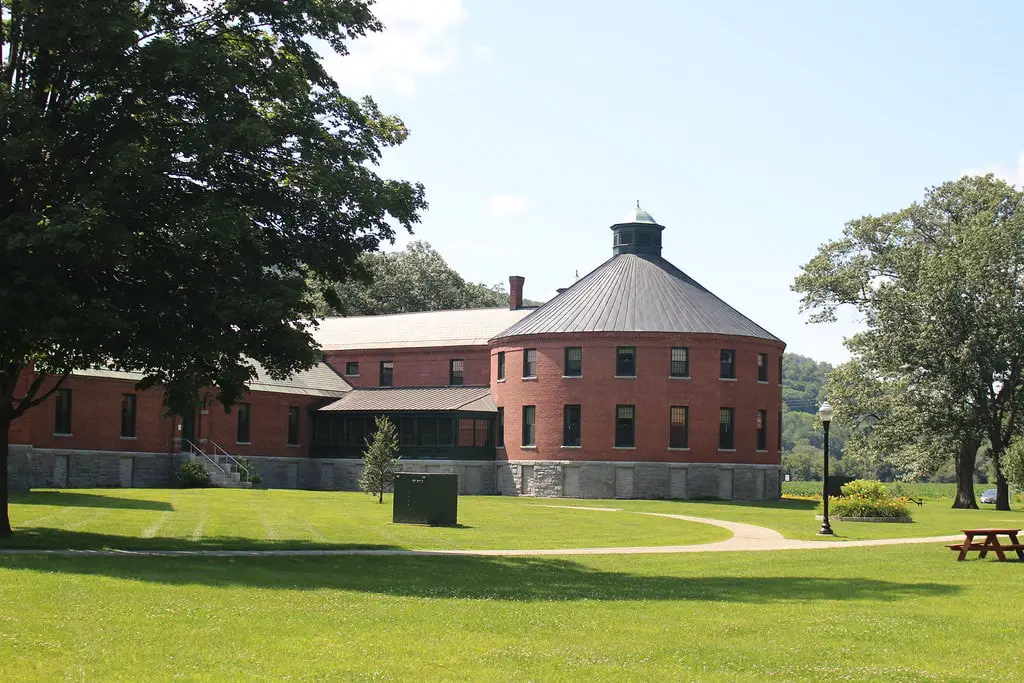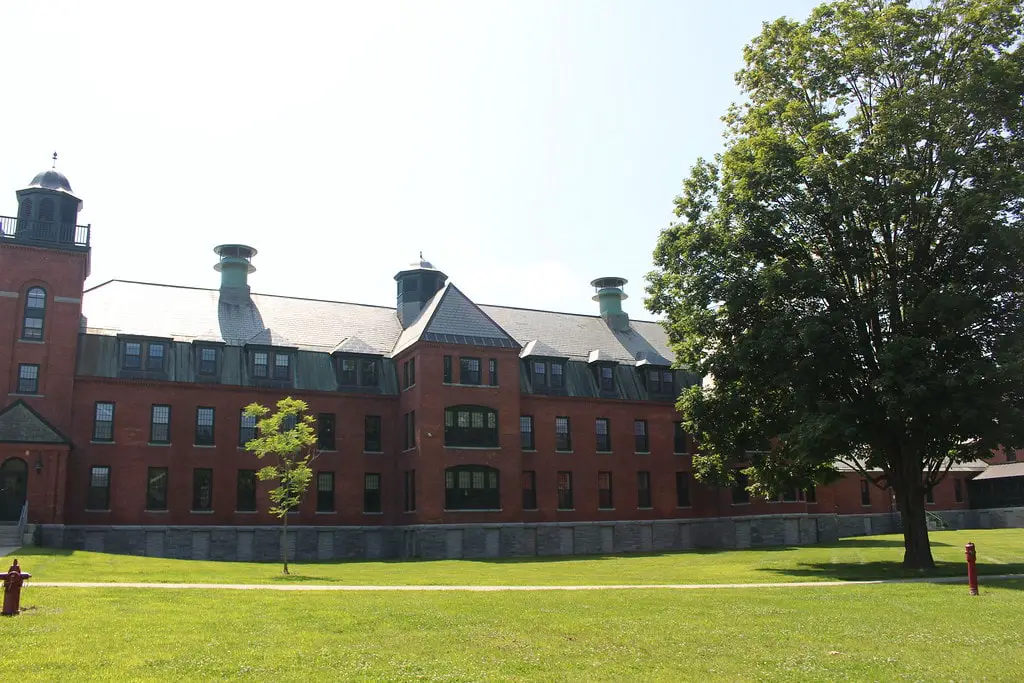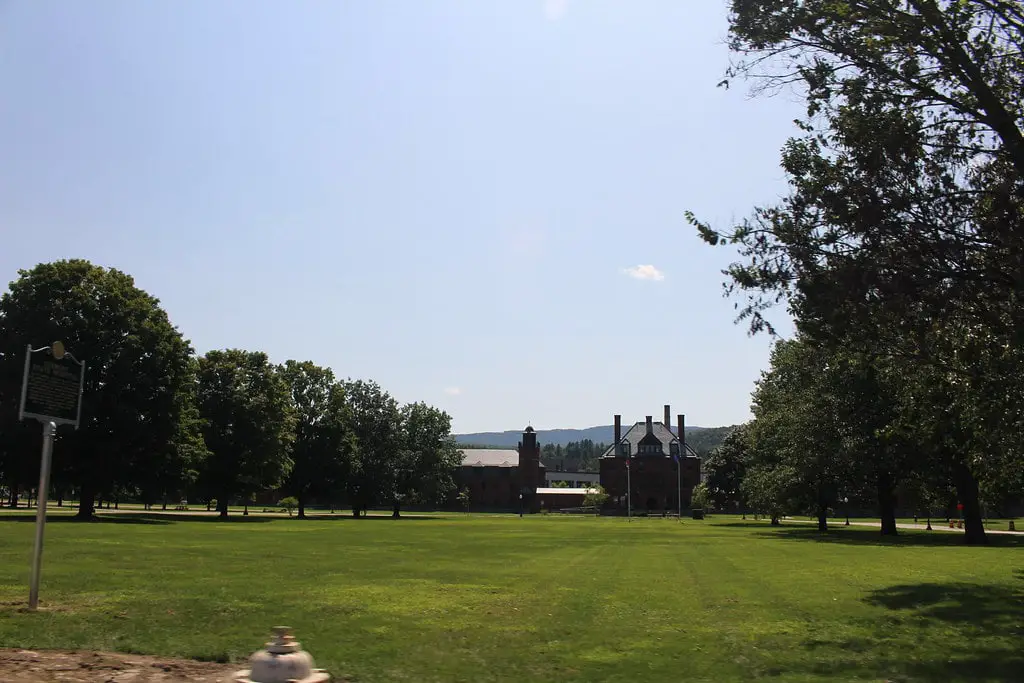The Founding Years and Architectural Marvels
In 1890, Vermont State Hospital opened its doors in Waterbury, Vermont, to solve the overcrowding issue at the Vermont Asylum for the Insane in Brattleboro. The hospital was initially designed to treat the criminally insane, a focus that would later expand to include a wide range of mental health conditions.
The hospital's architectural design was crafted by Rand and Taylor, featuring elements of Victorian, Colonial Revival, and Classical Revival styles. The hospital was built on a rusticated stone foundation, with a steep hipped slate roof, and was connected by single-story links to two-and-a-half-story wings.
The design emphasized the isolation of patients according to category, maximum light and air, and glazed sunrooms to mitigate Vermont's harsh climate.
The hospital's architecture was not just about aesthetics but also about functionality. The design included features like restricted height in the ward wings to facilitate egress in case of fire. The thousand-foot length of the roofline was animated with conical caps over the cylindrical wards and an array of shed, hipped, and gabled dormers, making it a landmark in Waterbury.
For those interested in architecture and history, visiting this monumental structure is one of the things to do in Waterbury, Vermont. The hospital's design reflects a bygone era, and its walls seem to tell fascinating and poignant stories.
Expansion and Controversies
The hospital underwent significant expansion during the tenure of Dr. Eugene A. Stanley from 1918 to 1936. Under his leadership, a new three-story building was constructed specifically for the treatment of women. The patient population peaked at 1,728 in the mid-1930s, making it a significant mental health facility in the state.

However, Dr. Stanley's tenure was not without controversy. He was an advocate for eugenics and forced sterilization, practices that are now considered unethical. His views were divisive and led to questionable treatments and procedures at the hospital.
The term "Waterbury" also gained a derogatory connotation during this period. It was used to imply that someone was insane or acting disagreeably. This slang term became part of the local lexicon, further stigmatizing the hospital and its patients.
Despite these controversies, the hospital played a critical role in Vermont's mental health care system. It was a place that, for better or worse, shaped the state's approach to mental health treatment for decades.

Natural Disasters and Their Impact
Natural disasters have played a significant role in the hospital's history. In 1927, the property was flooded, causing considerable damage. However, Tropical Storm Irene in 2011 had the most devastating impact, attacking the property 2.5 feet above the predicted 100-year level.
The flooding from Irene led to the hospital's closure. The damage was so extensive that the facility could not be salvaged, leading to a significant gap in mental health services in Vermont. The state had to scramble to find alternative solutions for displaced patients due to the closure.
The aftermath of Tropical Storm Irene led to a reevaluation of the state's mental health care infrastructure. It catalyzed change, prompting the state to invest in new facilities and rethink its approach to mental health care.
The hospital's closure was a moment of collective loss for the community. It marked the end of an era, and for many, it was a place filled with memories - some good, some bad, but all a part of Waterbury's rich history.

Transformation into the Waterbury State Office Complex
After its closure, the hospital transformed. The campus now houses various state offices and has been renamed the Waterbury State Office Complex. This adaptive reuse has breathed new life into the historic buildings while preserving their architectural integrity.
The complex was listed on the National Register of Historic Places in 2016, giving it a protected status. This listing ensures that the buildings will be preserved for future generations as a lasting reminder of the hospital's complex history and architectural significance.
The state's efforts to repurpose the hospital buildings have been largely successful. The complex now serves as a hub for administrative functions, relieving pressure for new office space in Montpelier, Vermont's capital.
For locals and visitors alike, the Waterbury State Office Complex is a monument to the community's resilience. It's a place that has adapted to the times while honoring its past, making it a source of local pride.

The Current State and Future Prospects
Vermont has not entirely abandoned the concept of a state-run mental health facility. As a partial replacement for the Vermont State Hospital, the state currently operates the Vermont Psychiatric Care Hospital in Berlin, Vermont.
Recent news indicates plans to transform part of the Vermont Psychiatric Care Hospital into an adult forensic facility starting in 2024. This new facility would cater to individuals who have been charged with serious crimes but are either deemed incompetent to stand trial or were found not guilty because of insanity.
This proposal has sparked debates and discussions at various levels of government. While some see it as necessary to fill a gap in the state's mental health care system, others argue that it could lead to ethical and legal complications.
As we look to the future, the legacy of the Vermont State Hospital continues to influence mental health care policies and practices in the state. Its history serves as both a cautionary tale and a source of inspiration, reminding us of the importance of compassionate and ethical mental health care.

The Hospital's Role in Mental Health Care Today
Vermont's mental health care landscape has evolved significantly since the closure of the Vermont State Hospital. The state now has a more decentralized system, with acute psychiatric care being provided at various hospitals across Vermont, including Rutland Regional Medical Center and the Brattleboro Retreat.
The hospital's legacy, however, continues to loom large. Its history serves as a reminder of the challenges and complexities associated with mental health care. It's a story deeply ingrained in the community's collective memory.
The hospital also played a pioneering role in occupational therapy. Its self-contained community included administration, residences, hospitals, a power plant, laundry, workshops, craft shops, and even an adjacent dairy farm for occupational work by the residents.
In the broader context of Vermont's health care system, the hospital's legacy is a touchstone for ongoing discussions about mental health care reform. It reminds us how far we've come and the work still needs to be done.

Vermont State Hospital: The Heart of Waterbury's History
The Vermont State Hospital in Waterbury has had a complex and often controversial history. From its founding years to its closure, it has been a place of hope and despair, of medical advancements and ethical dilemmas.
Its transformation into the Waterbury State Office Complex symbolizes the community's ability to adapt and evolve. The complex now stands as a testament to Waterbury's resilience and a monument to its rich history.
As we reflect on the hospital's past, we also look forward to the future. The ongoing debates and legislative actions concerning mental health care in Vermont continue the hospital's enduring legacy.

In the end, the Vermont State Hospital serves as a poignant reminder of the complexities of mental health care and the importance of preserving historical sites for future generations. It's a story that continues to unfold, profoundly shaping the community and the state.
